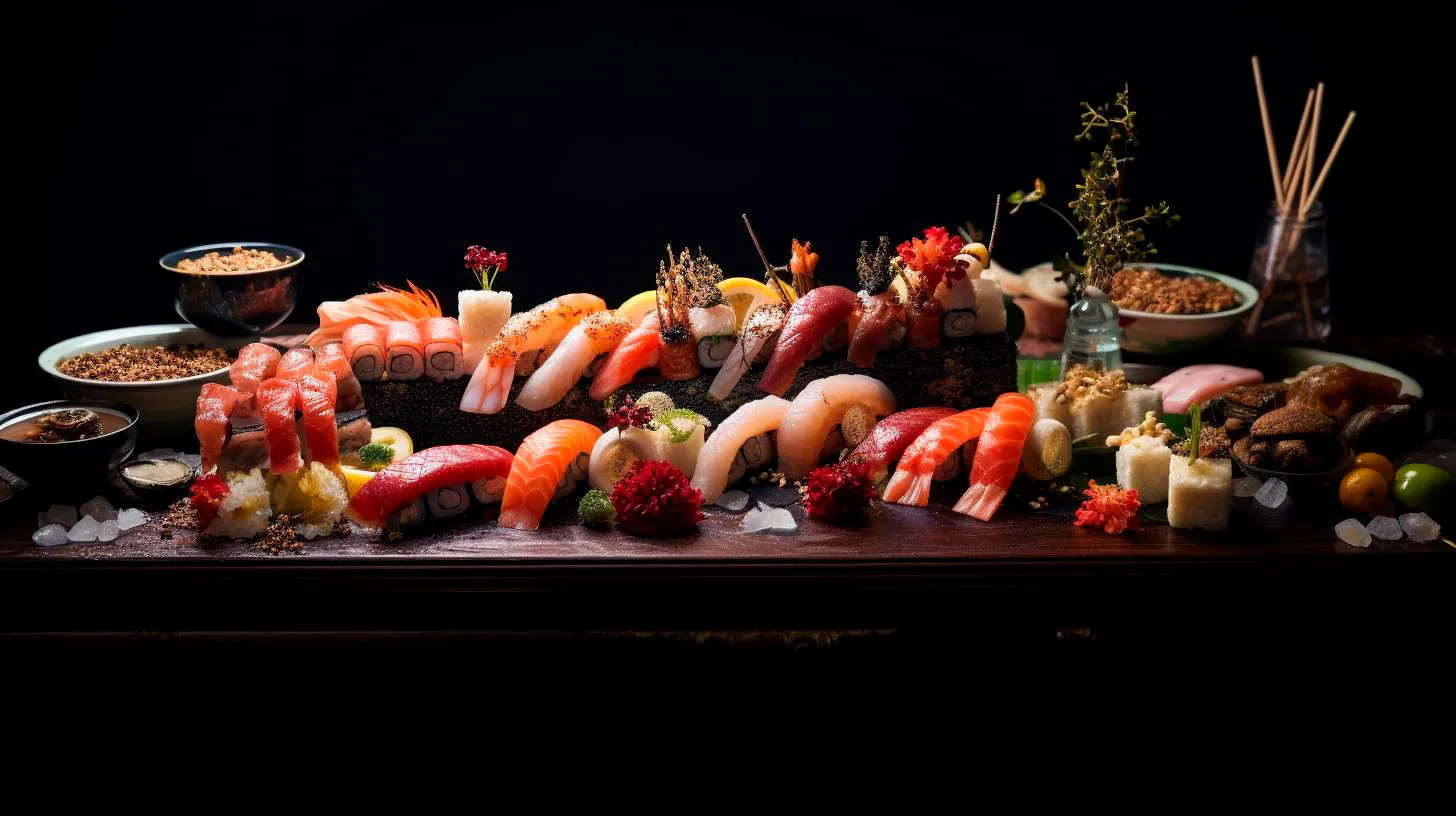Eco-friendly Sourcing Revolutionizing the Way Sushi Ingredients are Obtained
However, a new wave of eco-friendly sourcing methods is sweeping the sushi industry, revolutionizing the way ingredients are obtained.
The Environmental Impact of Traditional Sushi Ingredient Sourcing
Traditional sushi ingredient sourcing practices have had significant negative impacts on the environment. A few of these practices include:
- Overfishing: The demand for sushi ingredients, such as tuna and salmon, has led to overfishing in many regions. This overfishing disrupts marine ecosystems, threatening the balance of marine life.
- Harmful Fishing Techniques: Some traditional fishing techniques, like bottom trawling, can cause widespread damage to the seabed and destroy fragile coral reefs.
- Carbon Footprint: The transportation of sushi ingredients from distant locations generates a substantial carbon footprint. This contributes to greenhouse gas emissions and climate change.
The detrimental effects of these traditional practices have raised concerns among environmentalists, sushi enthusiasts, and conscious consumers alike.
The Rise of Eco-friendly Sourcing
Recognizing the need for sustainable practices, sushi chefs, suppliers, and restaurant owners are embracing eco-friendly ingredient sourcing methods. Here are some notable trends:
1. Responsible Fishing Methods
Responsible fishing methods, such as pole and line fishing, have gained popularity. This method ensures that fish are caught one by one, reducing bycatch and minimizing damage to marine ecosystems. It also promotes better quality fish, enhancing the taste and texture of sushi.
2. Locally Sourced Ingredients
Many sushi restaurants have started obtaining ingredients from local sources. By reducing transportation distances, the carbon footprint is significantly reduced. Additionally, local sourcing supports the local economy and fosters a stronger connection between sushi chefs and their communities.
3. Aquaculture and Sustainable Farming
Aquaculture, or fish farming, is playing a crucial role in sustainable sushi ingredient sourcing. Fish farms allow for controlled cultivation, reducing the need for wild-caught fish. Sustainable farming practices, such as using environmentally friendly feed and minimizing waste, are increasingly being adopted in the industry.
4. Conservation Partnerships
Sushi restaurants and suppliers are forming partnerships with environmental organizations and conservation groups to promote sustainable seafood practices. These partnerships help educate consumers about the importance of responsible sourcing and support initiatives that protect marine ecosystems.
The Advantages of Eco-friendly Sourcing
The shift towards eco-friendly sourcing methods offers several advantages:
- Preservation of Marine Ecosystems: By adopting sustainable practices, the delicate balance of marine ecosystems is protected, ensuring the continued availability of sushi ingredients for generations to come.
- Higher Quality Ingredients: Responsible fishing methods and sustainable farming practices result in higher quality ingredients, enhancing the taste and overall sushi experience.
- Reduced Carbon Footprint: By sourcing locally and adopting sustainable farming practices, the carbon footprint of the sushi industry is significantly reduced, contributing to a healthier planet.
- Consumer Demand: As more consumers prioritize sustainable dining options, sushi establishments that embrace eco-friendly sourcing methods have a competitive advantage in the market.
Key Takeaways
Eco-friendly sourcing is revolutionizing the way sushi ingredients are obtained, making the industry more sustainable and environmentally conscious. Key takeaways include:
- Traditional sushi ingredient sourcing practices have had detrimental effects on marine ecosystems and the environment.
- Eco-friendly sourcing practices like responsible fishing, local sourcing, sustainable farming, and conservation partnerships are gaining traction in the sushi industry.
- Eco-friendly sourcing offers advantages such as the preservation of marine ecosystems, higher quality ingredients, reduced carbon footprint, and meeting consumer demand for sustainable options.
By embracing these eco-friendly sourcing methods, the sushi industry can contribute to the preservation of our oceans and create a more sustainable dining experience, ensuring that sushi lovers worldwide can continue to enjoy their favorite cuisine for years to come.
Energy Efficiency in Sushi Kitchens: Embracing Green Technology and Practices
This not only helps the environment but also leads to significant cost savings for sushi restaurant owners. In this article, we will explore the importance of energy efficiency in sushi kitchens and highlight some key practices and technologies that can be adopted.
The Importance of Energy Efficiency in Sushi Kitchens
In sushi kitchens, energy is consumed in various forms, from refrigeration and lighting to cooking equipment and ventilation. These energy-consuming elements contribute to the overall energy usage and environmental impact of sushi restaurants. Therefore, improving energy efficiency in sushi kitchens offers several benefits:
- Cost Savings: Energy-efficient practices and technologies can significantly reduce utility bills, leading to substantial cost savings for sushi restaurant owners.
- Environmental Impact: By reducing energy consumption, sushi kitchens can lower their carbon footprint, contributing to the fight against climate change.
- Improved Reputation: Embracing energy-efficient practices demonstrates a commitment to sustainability, attracting eco-conscious customers who appreciate environmentally-friendly businesses.
Key Energy-Efficient Technologies and Practices for Sushi Kitchens
Now that we understand the importance of energy efficiency in sushi kitchens, let’s explore some key technologies and practices that can be implemented:
LED Lighting
Traditional incandescent or fluorescent lighting fixtures in sushi kitchens can be replaced with energy-efficient LED lights. LED lights consume significantly less energy and have a longer lifespan, providing both energy and maintenance cost savings. Furthermore, LEDs generate less heat, reducing the load on cooling systems and potentially saving extra energy.
Efficient Refrigeration Systems
A significant portion of energy consumption in sushi kitchens is attributed to refrigeration units. Upgrading to energy-efficient models with better insulation, temperature control, and advanced compressors can lead to substantial energy savings. Furthermore, regular maintenance and proper organization of refrigeration equipment ensure efficient airflow and prevent energy wastage.
Ventilation Systems
Sushi kitchens often require powerful ventilation systems to remove excess heat and maintain air quality. By installing energy-efficient ventilators and improving duct insulation, ventilation systems can operate more efficiently. Additionally, using demand-controlled ventilation, which adjusts ventilation rates based on real-time kitchen conditions, can further reduce energy consumption.
Induction Cooktops
Traditional gas burners used in sushi kitchens are not only inefficient but also pose safety risks. Switching to energy-efficient induction cooktops provides precise temperature control, faster cooking times, and improved safety. Induction cooktops use electromagnetic energy to directly heat the cookware, resulting in minimal energy loss and better overall efficiency.
Automatic Sensors and Controls
Implementing automatic sensors and controls in sushi kitchens can optimize energy usage. Motion sensors can detect occupancy and adjust lighting accordingly, reducing unnecessary energy consumption. Timers and programmable thermostats can be used to regulate cooking equipment and HVAC systems, ensuring they operate only when needed.
Key Takeaways
- Energy efficiency in sushi kitchens is crucial for cost savings, reducing environmental impact, and attracting eco-conscious customers.
- Implementing LED lighting, efficient refrigeration systems, improved ventilation, induction cooktops, and automatic sensors can significantly improve energy efficiency in sushi kitchens.
- Adopting these energy-efficient practices and technologies can lead to long-term cost savings, reduced greenhouse gas emissions, and improved overall sustainability for sushi restaurants.
By embracing green technology and practices, sushi kitchens can contribute to a more sustainable food industry. Implementing energy-efficient technologies not only helps reduce operational costs but also demonstrates a commitment to environmental stewardship. As an industry that relies heavily on energy-intensive operations, sushi kitchens have an opportunity to lead the way in embracing green practices and inspiring other food establishments to follow suit. By making these changes, sushi restaurant owners can create a win-win situation for both their businesses and the planet.
Innovative Packaging: The Rise of Sustainable Solutions in Sushi Restaurants
As a response to this demand, sushi restaurants are stepping up their game and adopting innovative packaging solutions that are both environmentally friendly and visually pleasing.
The Environmental Impact of Traditional Packaging
Traditional packaging for sushi often involves single-use plastic containers, Styrofoam trays, and excessive use of plastic wrap. These materials contribute to the global plastic pollution crisis and have a significant negative impact on the environment. They take hundreds of years to decompose, contribute to landfill waste, and pose a threat to marine life.
Thankfully, sushi restaurants are recognizing the need for change and are actively seeking sustainable packaging alternatives to minimize their ecological footprint.
The Rise of Sustainable Packaging Solutions
With sustainability in mind, many sushi restaurants are now embracing innovative packaging solutions that prioritize eco-friendly materials and packaging designs. Here are some notable examples:
- Biodegradable containers: Environmentally friendly containers made from biodegradable materials, such as bamboo and sugarcane, are gaining popularity. These containers decompose much faster than conventional plastic ones, reducing the long-term impact on the environment.
- Edible packaging: Some sushi restaurants have taken creativity to the next level by using edible packaging. These innovative solutions eliminate waste altogether, as customers can consume the entire package along with their sushi. Edible wrappers made from seaweed or rice paper provide a unique and sustainable dining experience.
- Reusable containers: Another trend that is gaining traction is the use of reusable containers. Sushi restaurants offer customers the option to purchase a durable and reusable container for their takeout orders. This not only reduces single-use plastic waste but also encourages customers to adopt a more sustainable lifestyle.
The Benefits of Sustainable Packaging
Embracing sustainable packaging solutions offers several advantages, not only for the environment but also for both sushi restaurants and their customers. Here are some key benefits:
- Positive brand image: Implementing sustainable packaging solutions enhances a restaurant’s brand image, showcasing their commitment to environmental responsibility. This can attract eco-conscious customers and differentiate the restaurant from competitors.
- Meeting customer expectations: As the market becomes more environmentally aware, customers are increasingly demanding sustainable options. By providing eco-friendly packaging, sushi restaurants can meet these expectations and cultivate a loyal customer base.
- Reduced costs: While some eco-friendly packaging options may have a slightly higher upfront cost, they often lead to long-term savings. Reusable containers, for example, reduce the need for single-use packaging, resulting in reduced expenses over time.
- Contribution to a cleaner environment: By choosing sustainable packaging, sushi restaurants can significantly reduce their environmental impact. This proactive step contributes to mitigating plastic pollution and promotes a greener planet for future generations.
Key Takeaways
The rise of sustainable packaging solutions in sushi restaurants signifies a positive shift towards environmentally conscious practices. By adopting innovative packaging alternatives, sushi establishments can cater to eco-conscious customers, reduce their carbon footprint, and enhance their brand image. Here are the key takeaways:
- Sushi restaurants are embracing sustainable packaging solutions to reduce their environmental impact.
- Biodegradable containers, edible packaging, and reusable containers are among the innovative solutions being adopted.
- Benefits include a positive brand image, meeting customer expectations, reduced costs, and a cleaner environment.
- Eco-friendly packaging contributes to mitigating plastic pollution and supports a sustainable future.
By choosing sustainable packaging options, sushi restaurants can help make a significant difference in the battle against plastic waste and create a more sustainable dining experience for all sushi lovers.
Introduction to Sustainable Sushi: Redefining the Restaurant Industry
Sustainable sushi refers to the concept of sourcing and preparing sushi in a way that minimizes its impact on the environment. This goes beyond just the ingredients used; it encompasses various factors such as fishing methods, species selection, waste reduction, and socially responsible business practices. Let’s explore the key elements that make sustainable sushi a game-changer for the restaurant industry.
1. Responsibly Sourced Fish
The foundation of sustainable sushi lies in responsibly sourced fish. Traditional fishing methods, such as bottom trawling and longlining, often result in high bycatch rates and damage to marine ecosystems. Sustainable sushi restaurants prioritize using sustainably caught fish, which includes options like line-caught, MSC-certified, and pole and line fishing.
- Choosing fish that are responsibly sourced helps preserve ocean biodiversity and supports local fishing communities.
- By promoting sustainable fishing practices, restaurant owners and customers contribute to the conservation of marine resources.
2. Plant-Based Alternatives
Vegetarian and vegan options have gained popularity in recent years, and sustainable sushi embraces this trend. By incorporating plant-based alternatives, such as tofu, mushrooms, and avocado, restaurants not only cater to a wider range of dietary preferences but also reduce the reliance on fish in sushi production.
- Plant-based options in sushi offer a sustainable alternative for those who want to reduce their environmental footprint.
- By diversifying the menu to include more plant-based choices, restaurants can attract a larger customer base and promote healthier and more environmentally friendly dining.
3. Reduction of Food Waste
Food waste is a significant challenge in the restaurant industry, and sushi restaurants are no exception. However, sustainable sushi establishments aim to minimize waste through various strategies, such as careful portion control, creative usage of leftovers, and educating both staff and patrons about the importance of reducing food waste.
- Effective food waste management not only reduces environmental impact but also increases operational efficiency and saves costs for restaurant owners.
- By encouraging customers to take part in the effort to reduce food waste, sustainable sushi restaurants foster a sense of community and shared responsibility.
4. Local and Organic Ingredients
Sustainable sushi is all about sourcing ingredients locally and emphasizing organic produce. By supporting local farmers and reducing the carbon footprint associated with long-distance transportation, restaurants contribute to the growth of local economies and reduce greenhouse gas emissions.
- Using organic ingredients ensures that sushi is free from harmful chemicals and pesticides, promoting healthier and more sustainable dining choices.
- By highlighting local and seasonal ingredients, sustainable sushi restaurants provide customers with a unique and authentic dining experience.
Key Takeaways
- Sustainable sushi promotes responsible fishing practices and offers a variety of responsible sourcing options.
- Integrating plant-based alternatives diversifies the menu and offers sustainable options for customers.
- Reducing food waste through strategy implementation benefits the environment and the restaurant’s bottom line.
- Choosing local and organic ingredients supports local communities and reduces the carbon footprint.
Sustainable sushi is more than just a culinary trend; it is a movement that redefines the restaurant industry. By embracing responsible sourcing, reducing waste, and promoting eco-friendly practices, sustainable sushi restaurants lead the way in creating a more sustainable and environmentally conscious dining experience. Let’s make a positive change, one sushi roll at a time.



